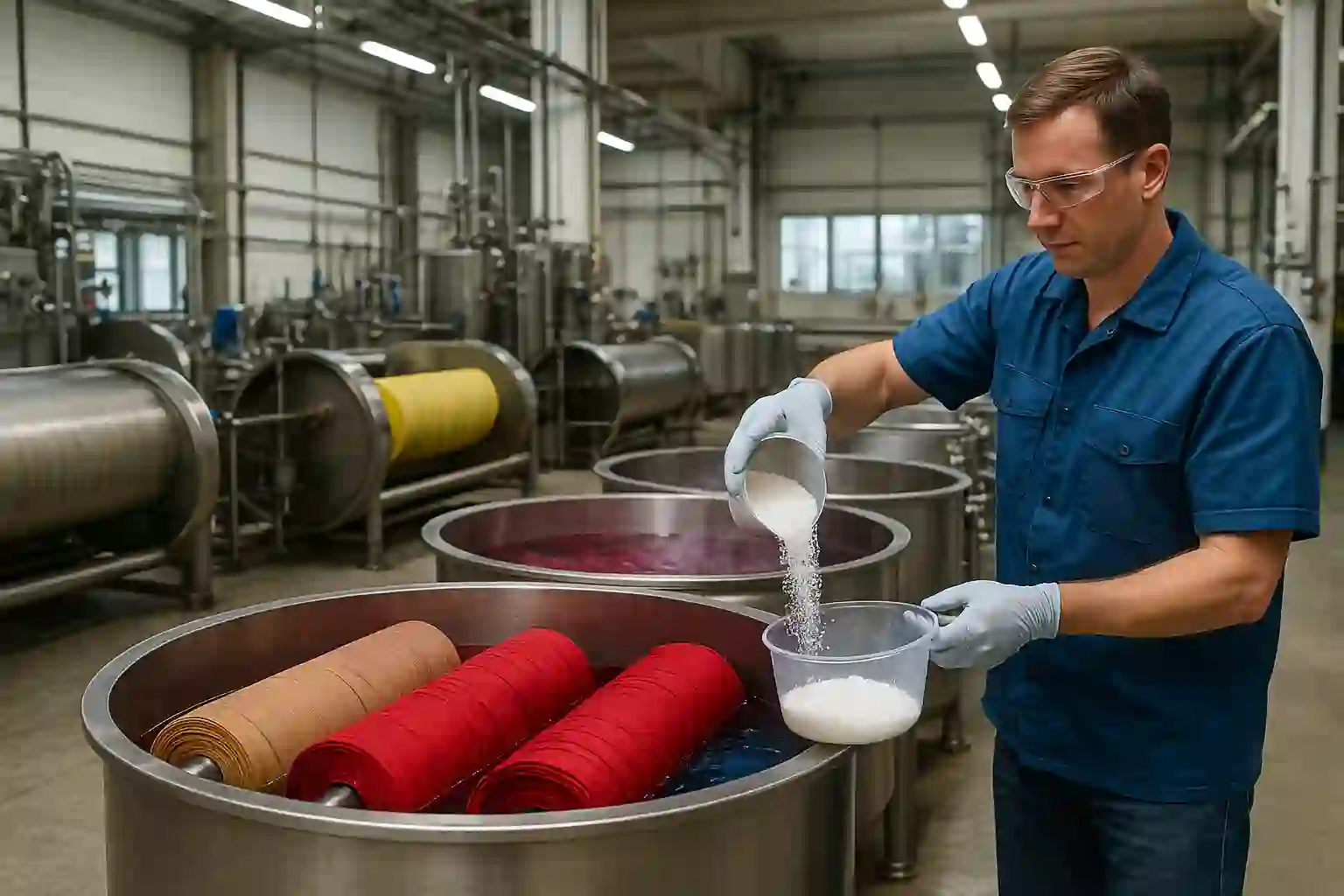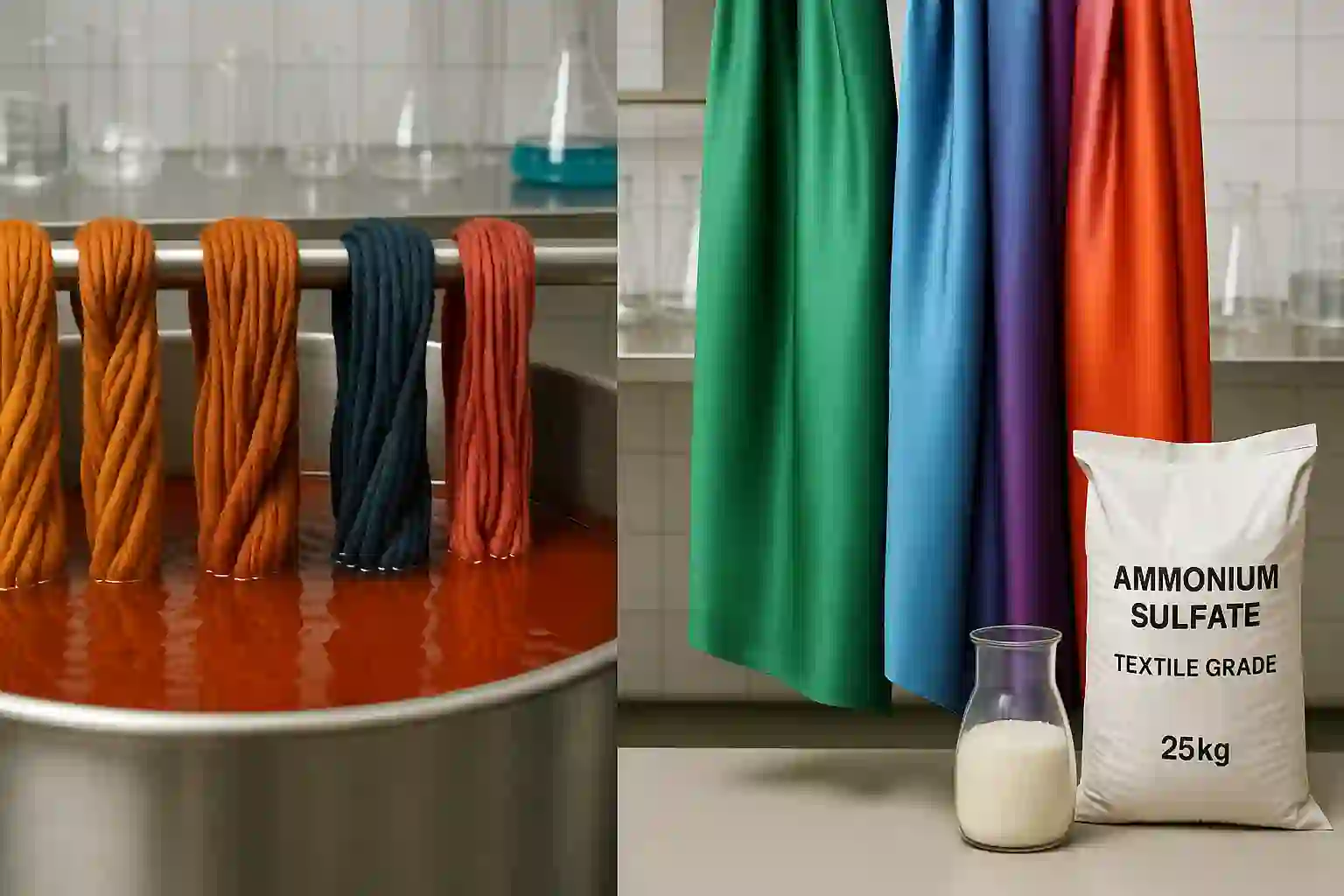Applications of Ammonium Sulfate in the Textile Industry: A Comprehensive Guide for Fabric Manufacturers
The textile industry is one of the oldest and most extensive industries in the world, constantly facing numerous challenges in dyeing, finishing, and improving product quality. In this context, the use of various chemicals plays a significant role in enhancing process efficiency and the final quality of fabrics. One of these key chemicals is ammonium sulfate.
The application of ammonium sulfate in the textile industry has gained special importance for several reasons, including its ability to adjust pH, improve dye uptake, enhance color uniformity, and reduce production costs. Many large textile factories worldwide use this chemical to achieve better results in dyeing both natural and synthetic fibers.
In this comprehensive article, we will explore 10+ main applications of ammonium sulfate in the textile industry and understand why this chemical can be a strategic choice for fabric manufacturers.
What is Ammonium Sulfate and Why is it Important in Textiles?
Ammonium sulfate ((NH4)2SO4) is an inorganic salt widely used in various industries, including agriculture, pharmaceuticals, and textiles. Due to its special chemical properties, particularly its ability to regulate acidic and alkaline environments, it plays a key role in dyeing processes.
Key features of ammonium sulfate for the textile industry include:
High solubility in water: Easily dissolves in dye baths.
pH regulation: Precisely controls the dye bath environment.
Chemical stability: Maintains consistent performance under different temperatures and pressures.
Cost-effectiveness: Lower cost compared to similar chemicals, resulting in production savings.
For these reasons, the use of ammonium sulfate in textiles not only improves fabric quality but also reduces production costs.
1. Ammonium Sulfate for pH Adjustment in Dye Baths
One of the most important steps in dyeing is adjusting the pH of the dye bath. If the pH is too acidic or alkaline, the dye may not properly adhere to fibers or may lack stability. Ammonium sulfate acts as a natural buffer, keeping the dye bath within the optimal range.
Cotton dyeing with reactive dyes: Slightly alkaline pH is needed for proper reaction between dye and cellulose.
Wool and silk dyeing: Mildly acidic pH protects the protein structure of fibers.
Adding ammonium sulfate ensures this balance, allowing the dyeing process to proceed with maximum efficiency.
2. Ammonium Sulfate for Dyeing Cotton and Improving Color Uptake
Cotton fibers, one of the most widely used natural fibers, often face challenges in dyeing. One common issue is uneven or insufficient dye absorption. Ammonium sulfate, due to its ionic properties, prepares the environment for better reaction between reactive dyes and cellulose.
Benefits:
Enhanced color depth and brightness
Improved wash and light fastness
Reduced dye consumption, resulting in cost savings
Example: Industrial studies showed that using ammonium sulfate reduced dye usage by up to 15% without compromising color quality.
3. Ammonium Sulfate for Color Fixation in Wool and Silk
Protein fibers like wool and silk are sensitive to environmental conditions. Improper pH can damage their structure and reduce product quality.
Roles of ammonium sulfate:
Adjusts pH to a mildly acidic range (4.5–5.5), optimal for wool and silk dyeing
Improves color fastness against washing and perspiration
The result: wool and silk fabrics have more vibrant colors and maintain quality over time.
4. Ammonium Sulfate for Dyeing Synthetic Fibers (Polyester, Nylon, Acrylic)
Synthetic fibers such as polyester, nylon, and acrylic make up a large part of the global textile market. A major challenge is the penetration of dyes into the compact, nonpolar structure of these fibers.
Ammonium sulfate modifies the ionic strength of the dye bath, enabling better dye attachment to fiber molecules.
Advantages:
Increased dye uptake in polyester and nylon
Improved uniformity in acrylic dyeing
Reduced need for very high temperatures
📌 Further reading: ResearchGate on synthetic fiber dyeing
5. Ammonium Sulfate for Fixing Reactive and Thick Dyes
Reactive and thick dyes are widely used in textiles but fixing them on fibers is not always easy. Ammonium sulfate, due to its ionic nature, creates an environment where dye-cellulose reactions are more complete.
Outcomes:
Higher percentage of dye fixation on cotton fibers
Reduced need for other salts like sodium chloride
Cost savings in wastewater treatment
6. Ammonium Sulfate for Color Uniformity and Preventing Streaks
A common problem in dyeing is the formation of uneven patches or streaks, leading to significant waste.
Ammonium sulfate controls the ionic strength of the dye bath, regulating dye-fiber reaction speed. This ensures uniform color distribution across the fabric surface.
7. Ammonium Sulfate in Fabric Finishing
The finishing process enhances fabric quality after dyeing and washing. Ammonium sulfate is sometimes used in finishing formulations to:
Increase softness and smoothness
Improve water and dye absorption
Enhance resistance to wear and tear
8. Ammonium Sulfate as a Flame Retardant
An interesting feature of ammonium sulfate is its use as a flame retardant. It releases non-flammable gases at high temperatures, slowing down combustion.
Applications: Industrial clothing, heavy curtains, and fabrics for exhibition halls.
9. Ammonium Sulfate for Reducing Dye Consumption and Cost Savings
Using ammonium sulfate in dye baths increases dye uptake efficiency, reducing dye consumption by 10–20%.
Results:
Lower production costs
Reduced colored wastewater
Enhanced environmental sustainability
10. Ammonium Sulfate for Improving Washing and Reducing Dye Waste
After dyeing, fabrics typically require repeated washing to remove unbound dye. Ammonium sulfate helps:
Reduce free dye in wash water
Decrease washing frequency
Save water and energy
11. Ammonium Sulfate in the Production of Direct Dyes and Pigments
Certain processes for producing direct dyes and pigments require ammonium sulfate. It acts as a reaction helper, improving the final dye quality.
12. Ammonium Sulfate for Extending Machinery Life and Reducing Corrosion
Improper pH in dye baths and washing can corrode tanks, pipes, and textile machinery. Ammonium sulfate regulates pH, minimizing corrosion and extending equipment life.
Advantages and Disadvantages of Using Ammonium Sulfate in Textiles
Advantages:
Effective pH regulation in dyeing processes
Enhanced color quality and stability in natural and synthetic fibers
Economic savings due to reduced dye and energy use
Reduced colored wastewater and improved environmental sustainability
Protection of textile machinery against corrosion
Disadvantages:
Requires proper dosage management to prevent precipitation or side effects
Excessive use may increase wastewater salinity
Workers’ exposure requires safety precautions
Comparison of Ammonium Sulfate and Sodium Sulfate in Textiles
Sodium sulfate (Na2SO4) is also commonly used in dyeing.
Differences:
Sodium sulfate mainly acts as a carrier to improve dye solubility, while ammonium sulfate focuses on pH regulation and color fixation
Ammonium sulfate often reduces dye consumption
Both are cost-effective, but using ammonium sulfate can reduce wastewater pollution in some processes
Environmental Effects and Wastewater Management
One of the main concerns in textiles is managing colored wastewater. Ammonium sulfate reduces the need for dye and improves fixation, decreasing free dye in wastewater.
However, excessive use may increase water salinity. Modern textile factories use advanced treatment systems (like reverse osmosis and membrane bioreactors) to recycle wastewater.
Price and Purchase Guide for Ammonium Sulfate in Textiles
Choosing the right ammonium sulfate can make a big difference in fabric quality.
Factors affecting price:
Purity: 99% is ideal for dyeing
Country of origin: China, Iran, Turkey, India are main suppliers
Packaging: 25 kg bags or 1000 kg bulk bags
Shipping costs and currency fluctuations
Purchase recommendations:
Buy from suppliers providing a Certificate of Analysis (COA)
Product should dissolve easily in water and be free from insoluble impurities
📌 Global price reference: Alibaba – Ammonium Sulfate Textile Grade
Table Applications of Ammonium Sulfate in Textiles
| Main Application | Effect on Textile Process | Final Benefit |
|---|---|---|
| pH adjustment in dye baths | Controls acidic/alkaline conditions | Improved dye quality |
| Cotton dyeing | Enhances reactive dye reaction | Reduced dye usage |
| Color fixation in wool and silk | Maintains mildly acidic environment | Increased color fastness |
| Synthetic fiber dyeing | Improves dye uptake | Better color uniformity |
| Fixing reactive and thick dyes | Completes dye-fiber reaction | Longer-lasting color |
| Color uniformity | Prevents streaks | Better appearance |
| Fabric finishing | Softening and anti-crease | Added value |
| Flame retardant | Reduces flammability | Safer fabrics |
| Reduced dye usage | Increases efficiency | Cost savings |
| Improved washing | Reduces dye in wastewater | Saves water |
Frequently Asked Questions
Is ammonium sulfate suitable for all textile fibers?
Yes, but dosage and conditions vary depending on the fiber type (cotton, wool, polyester, etc.).Can it replace sodium sulfate?
In some processes, yes, but its main function is pH regulation, not dye solubility.Does it reduce environmental pollution?
Yes, it lowers free dye in wastewater.What purity is recommended for textiles?
Over 99% purity provides the best performance.Is it used as a flame retardant in textiles?
Yes, in some industrial and protective fabrics.Does it corrode dyeing equipment?
No, it actually helps prevent corrosion by regulating pH.Is it useful for natural dyes?
Yes, it helps better fixation of plant-based colors.Does it reduce production costs?
Yes, through reduced dye, energy, and water consumption.Standard packaging:
Usually 25 or 50 kg laminated moisture-proof bags.Where to buy high-quality ammonium sulfate for textiles?
From reputable domestic and international brands with COA and quality assurance.
Conclusion
As we have seen, ammonium sulfate has extensive applications in the textile industry—from pH regulation in dye baths to color fixation, uniformity, and even flame retardancy. This cost-effective chemical can significantly improve the final quality of textile products.
If you are looking for high-quality ammonium sulfate for your textile factory, our brand offers products with guaranteed purity, standard packaging, and competitive pricing.
📌 Contact our experts now for free consultation.
Experience a greener, more economical, and higher-quality production with us.


